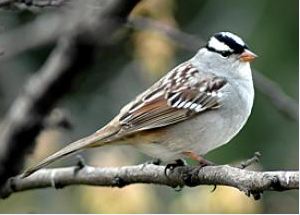
SCIENTIFIC NAME
Zonotrichia leucophrys
DESCRIPTION
The most distinctive feature of this relatively large sparrow, as reflected in its name, is the striped crown. Its grey head is crowned with conspicuous black and white stripes. The white-crowned sparrow lacks the yellow spot near each eye and the white throat of the white-throated sparrow, a close relative. This bird is approximately 17 - 19 cm in size. Loud scuffling in the bushes often signals the presence of this spirited bird. Using both of its rather large feet, it vigorously scratches among the leaf litter in search of food.
RANGE
The white-crowned sparrow spends its summer in British Columbia, western Alberta and then to the northern territories and out to Newfoundland and Labrador. Migration will take this bird from the Canadian east coast through Quebec, Ontario and the prairies. This bird winters mostly throughout the United States.
HABITAT
While many sparrows travel in mixed flocks, the white-crowned is more of a loner, preferring to travel individually or in small groups with others of its kind. It frequents clearings, meadows, forest edges, parks, and gardens that provide shrub cover.
DIET
White-crowned Sparrows eat mainly seeds of weeds and grasses and grains including oats, wheat, barley and corn. They also consume considerable numbers of caterpillars, wasps, beetles, and other insects during the summer.
BEHAVIOUR
undefinedPRIMARY ECOSYSTEM ROLES
Photo Gallery
To have the white-crowned sparrow visit your yard you need to know that the preferred food of this energetic bird is grass and weed seed, so allow an area of your garden to go a bit wild and do not cut back seed heads. Create a patch of prairie meadow with wildflowers and grasses for an abundant seed source. In spring and summer, the white-crowned sparrow also requires insects, so avoid the use of pesticides. A hedgerow along a field edge provides sheltered hunting grounds. Seeds on a low platform feeder may tempt this ground feeder to make a migratory stopover.
